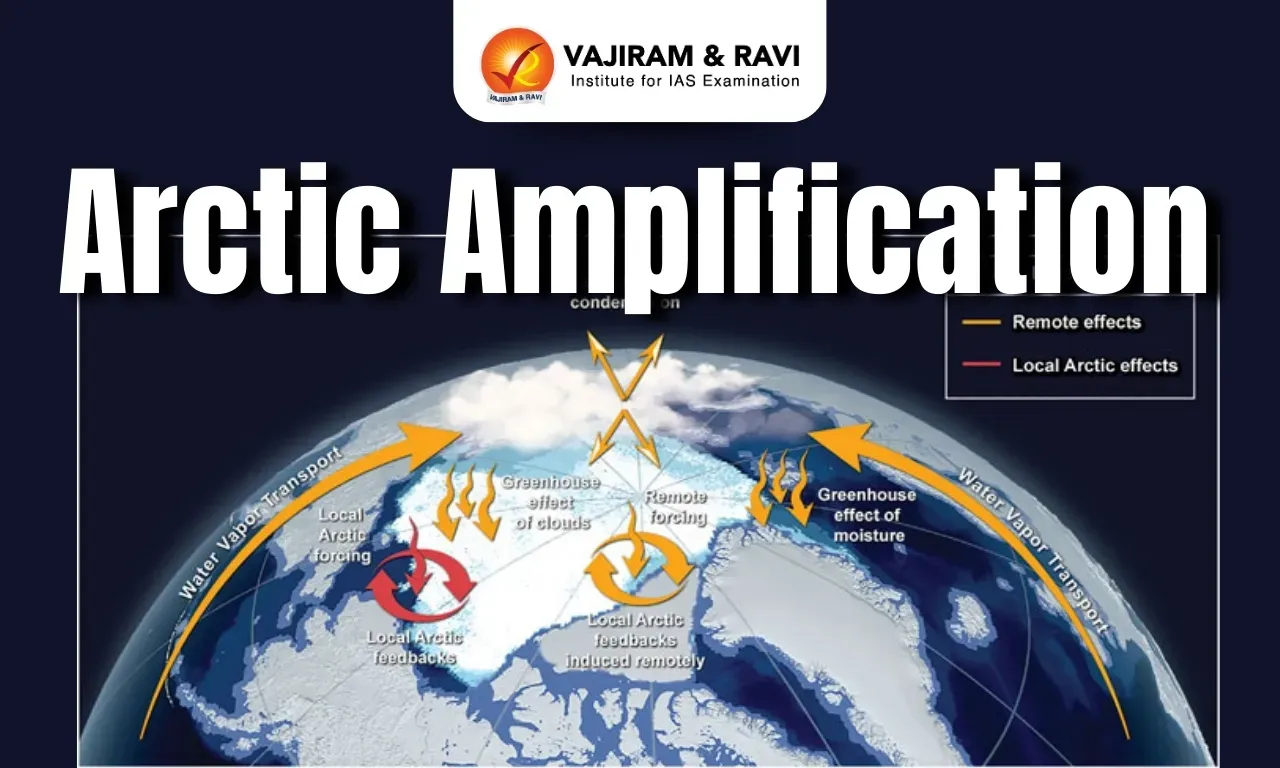Arctic Amplification Latest News
According to the 2024 European State of the Climate Report, Europe has warmed nearly twice as much as the global average, with far-reaching climatic and ecological consequences.
What is Arctic Amplification?
- Arctic amplification is a phenomenon where temperature changes in the polar regions, especially the Arctic, are more intense than the global average temperature change.
- It is a form of polar amplification, which occurs when changes in Earth’s atmosphere lead to a greater rise in temperatures near the poles than in other parts of the world.
- This effect is measured against the average temperature rise of the planet and is particularly pronounced in the northern polar regions, hence the term Arctic amplification.
- The phenomenon is primarily driven by changes in the net radiation balance of the atmosphere, especially due to the increase in greenhouse gases like CO₂ and methane, which trap more heat in the Arctic region.
- The major contributing factors to Arctic amplification are: Ice-Albedo Feedback, Lapse Rate Feedback, Water Vapour Feedback & Ocean Heat Transport.
Key Highlights from the 2024 European State of the Climate Report
- The Arctic region is warming three to four times faster than the global average, a phenomenon called Arctic Amplification.
- This is due to the melting of Arctic ice, reducing the albedo effect, where ice (which reflects sunlight) is replaced by darker surfaces (land or water) that absorb more solar radiation, enhancing warming.
- Warming Trends in Europe vs. Global Averages:
- The global average temperature has risen by approximately 1.3°C above pre-industrial levels (1850–1900 baseline).
- In 2024, the planet crossed the critical 1.5°C threshold for the first time.
- Europe’s average temperature has increased by about 2.4°C, making it one of the fastest-warming regions on Earth.
- This accelerated warming has led to extreme weather events, including intense heat waves, heavy rainfall, and flooding.
- Regional Climatic Contrasts Within Europe:
- The Eastern part of Europe experienced warmer and sunnier conditions.
- Western Europe witnessed cloudier and wetter weather.
- Southeastern European countries (e.g., Bulgaria, Romania, Serbia, Croatia) saw their longest heatwave on record in 2024.
- The number of ‘cold stress days’ was the lowest ever, and below-freezing temperature days dropped significantly.
Source: IE
Last updated on July, 2025
→ UPSC Notification 2025 was released on 22nd January 2025.
→ UPSC Prelims Result 2025 is out now for the CSE held on 25 May 2025.
→ UPSC Prelims Question Paper 2025 and Unofficial Prelims Answer Key 2025 are available now.
→ UPSC Calendar 2026 is released on 15th May, 2025.
→ The UPSC Vacancy 2025 were released 1129, out of which 979 were for UPSC CSE and remaining 150 are for UPSC IFoS.
→ UPSC Mains 2025 will be conducted on 22nd August 2025.
→ UPSC Prelims 2026 will be conducted on 24th May, 2026 & UPSC Mains 2026 will be conducted on 21st August 2026.
→ The UPSC Selection Process is of 3 stages-Prelims, Mains and Interview.
→ UPSC Result 2024 is released with latest UPSC Marksheet 2024. Check Now!
→ UPSC Toppers List 2024 is released now. Shakti Dubey is UPSC AIR 1 2024 Topper.
→ Also check Best IAS Coaching in Delhi
Arctic Amplification FAQs
Q1. What is Arctic Amplification?+
Q2. What causes Arctic Amplification?+
Q3. How does Arctic Amplification affect global climate?+
Tags: arctic amplification Prelims Pointers upsc current affairs upsc prelims current affairs















